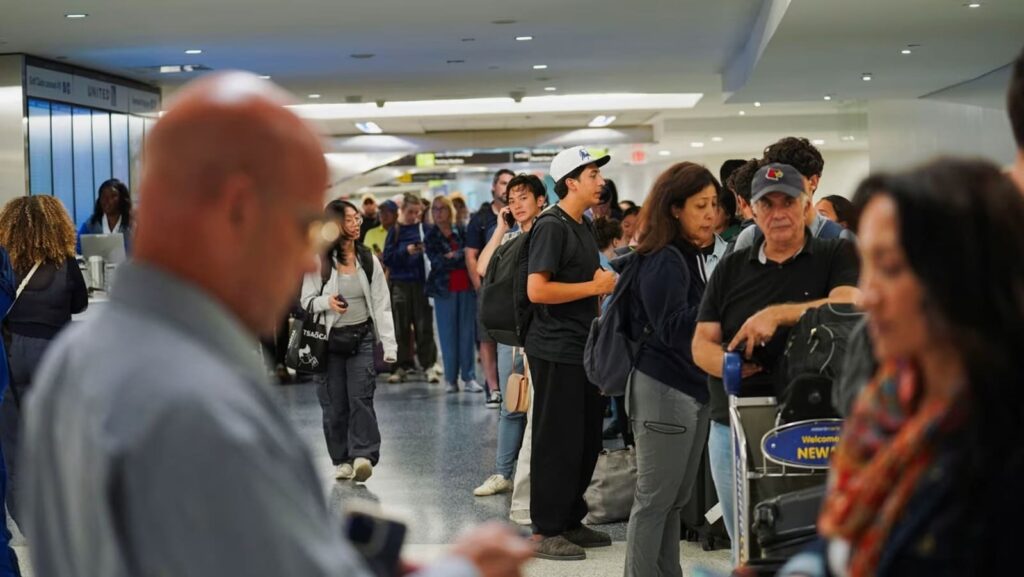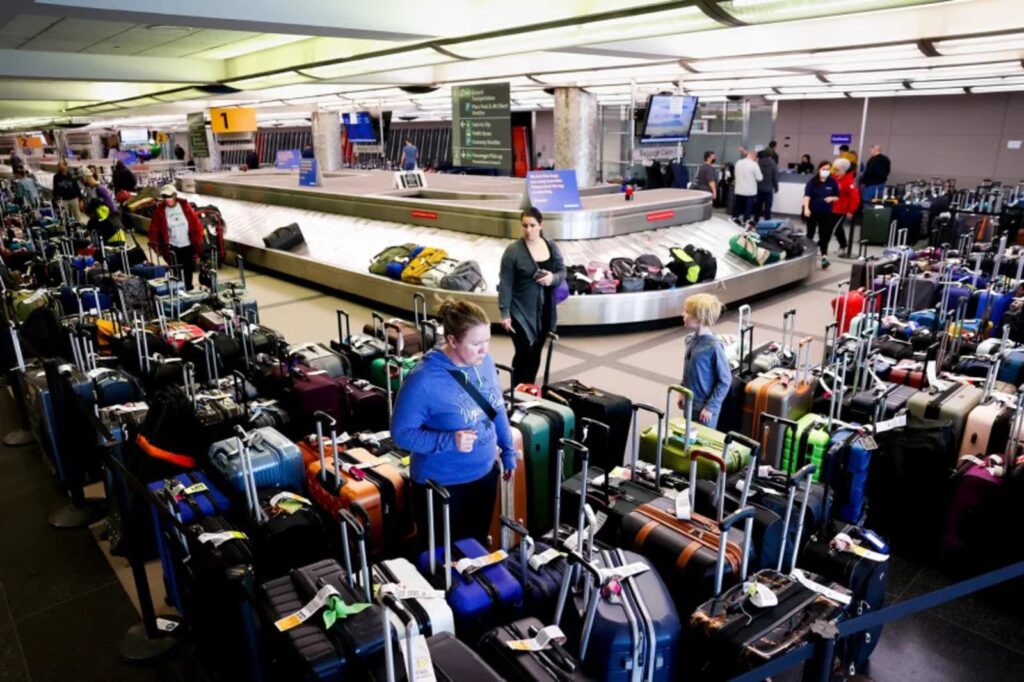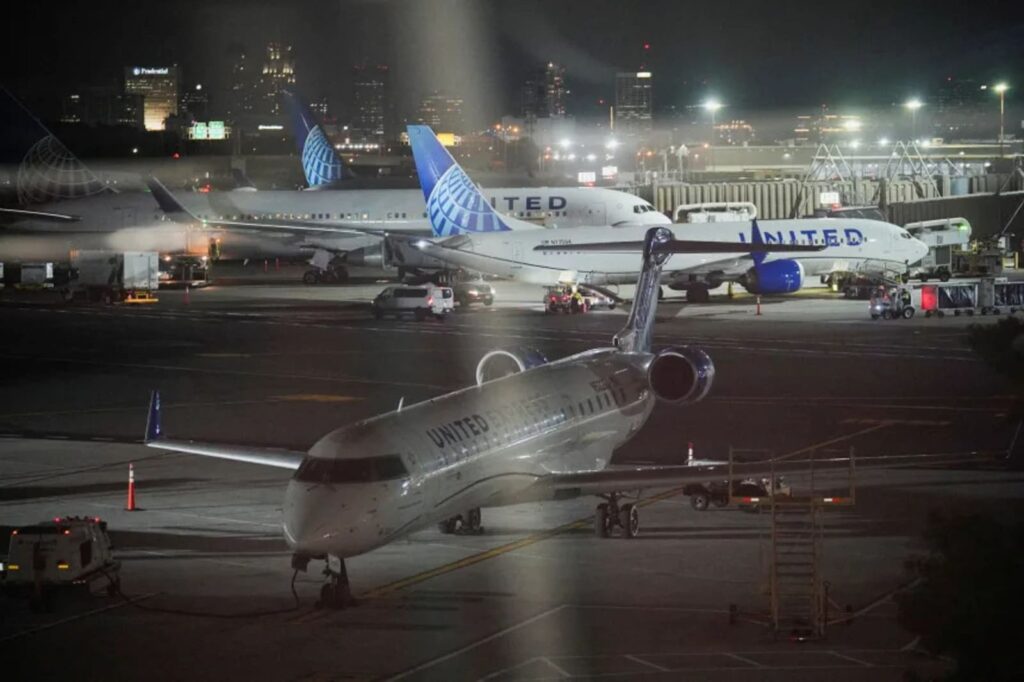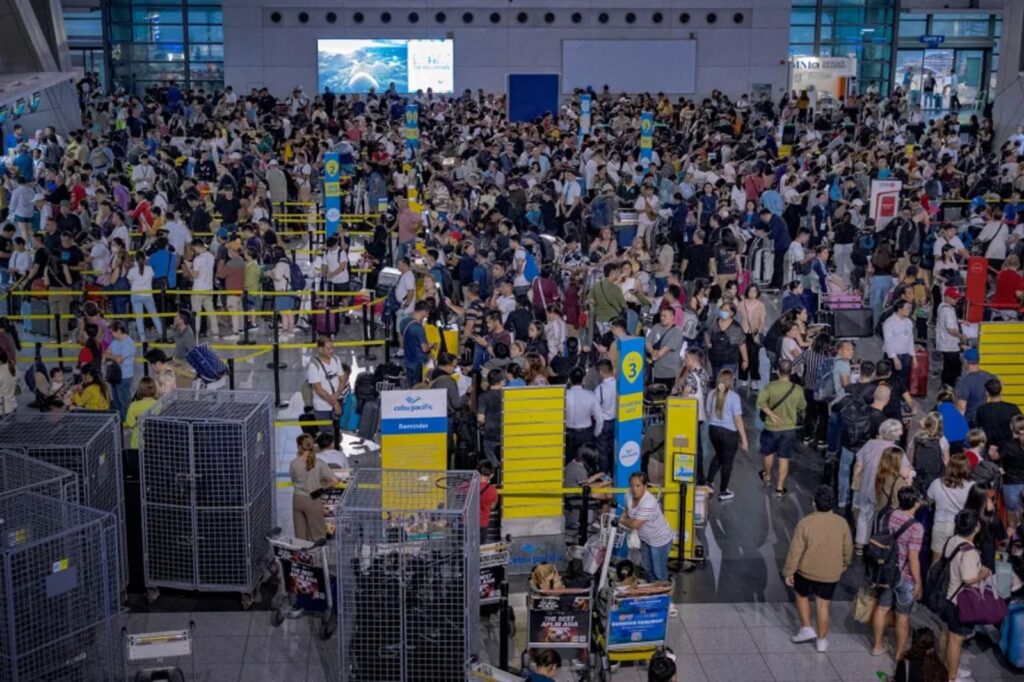
Travelers wait in line for delayed luggage at Newark Liberty International Airport after United Airlines grounded flights because of a tech outage on August 6. Ryan Murphy/Reuters
When a United Airlines “technology issue” halted several thousand flights a few weeks ago, it added another incident to a cascade of problems the airlines and national aviation system have seen in recent years.
Southwest Airlines had one of the most significant technology meltdowns in recent aviation history three years ago, during Christmas, when crew scheduling software failed, stranding passengers, their belongings and crew members all over the country.
Since then, the US has seen multiple Notice to Airmen outages affecting the federal computer system that sends alerts to pilots about conditions that could affect the safety of their flights. Plus airplanes have been grounded by tech issues affecting various airlines and the more wide-reaching CrowdStrike software glitch that’s been described as the “largest IT outage in history.”
These operational interruptions, while disruptive to passengers, happen because airlines and aviation officials see safety as paramount, said Eash Sundaram, a tech investor and venture capital and digital executive who previously served as executive vice president and chief digital and technology officer at JetBlue Airways.
“The moment the airline doesn’t have an IT system, they shut down the process,” said Sundaram.
United’s outage earlier this month was resolved within a few hours and the airline implemented delays and cancellations to return operations to normal.
But it shows that commercial air travel for the roughly three million people that take to the sky each day in the United States can be a complex dance, requiring technology that tracks everything from crew members and aircraft to the weight of planes to be running correctly. And if any one of these systems gives out, it can have a cascading effect.
While there’s no centralized data tracking tech outages across the national aviation system, “these software problems do happen far more often than anyone would like,” said Henry Harteveldt, president of Atmosphere Research Group and a travel industry analyst.
Aviation analysts and experts say it’s not a one-size-fits-all solution when it comes to fixing the technology.

Southwest Airlines’ meltdown during the Christmas holiday season in 2022 stranded passengers, bags and crew members. Michael Ciaglo/Getty Images
What’s the solution?
Sundaram said the very complex systems that often go down in these situations are owned or created by an individual airline. Each airline tends to run on its own system.
“Delta has its own crew management system, and American has its own crew management system … Nothing is common,” he said. “This is a fundamental issue in the industry.”
He pointed to operating systems, the “backbone” systems that support crew, the aircraft and weight and balance systems, as something that could be more universal for airlines. Commercial systems, such as e-commerce sites or check-in kiosks, could remain differentiated by each airline, he said.
“Why can’t four or five airlines come together to build it?” Sundaram said. “Why can’t Google invest in it, or why can’t Microsoft invest in it? Large airlines tend to invest on their own, and they build their own stuff, and once they build it, they don’t upgrade it for years, because, you know, it works.”
Until it doesn’t.

United Airlines planes sit grounded at Newark Liberty International Airport in Newark, New Jersey, on August 6. Ryan Murphy/Reuters
United’s problem a few weeks ago stemmed from an issue with the airline’s weight and balance computer system, known as Unimatic, and was unrelated to recent cybersecurity concerns in the industry, the company said. It’s not clear what caused the problem.
The airline hasn’t been a stranger to disruption this year, after multiple air traffic control communications outages impacted its massive operations at Newark Liberty International Airport.
The overhaul of the Federal Aviation Administration’s decades-old air traffic control system is currently underway, with a $12.5 billion down payment secured in President Trump’s landmark tax and spending cuts bill passed earlier this year.
Despite the chaos at Newark, the internal systems for United ran great, said Harteveldt.
“It could be that they were doing some kind of upgrade to the system, or it could be, again, that there was some kind of connectivity issue that caused the weight and balance system to go off, or something like that, but I don’t believe that the problem was triggered by some summer travel volumes,” he said.
This week, an air traffic control frequency outage grounded flights into Newark. The ground stop was lifted quickly, but flights were delayed due to “equipment issues” in the Philadelphia TRACON responsible for Newark arrivals and departures. The FAA has previously said Newark’s technology problems should be fixed by October.
But airlines’ own technology systems are in play, too.
Harteveldt said airlines have been investing in technology, but it’s not always the case that every single airline is running the “latest and greatest software.”
As with any technology, upgrades need to be made from time to time.
Recent technology outages
One of the largest and most catastrophic technology meltdowns was Southwest’s in 2022. The ripple effect of systems failing led to millions in fines and a federal government-led investigation of the airline. The airline’s reputation was damaged, and it had to make efforts to earn customers back.
Southwest unveiled an “action plan” after the meltdown which called for increasing the availability of winter equipment and staffing at some airports, investing in technology to help it quickly restart operations during extreme weather and improving communication and decision-making processes across departments that handle flight operations
Since then, passengers have seen several outages from various airlines, causing ground stops, ground delays and other disruptions.
What’s important to remember, according to Harteveldt, of Atmosphere Research Group, is that when the FAA tells an airline that a technology issue poses a safety issue, the airline puts safety first and complies with the FAA’s request to ground flights. That’s when travelers are disrupted by flight delays or cancellations.
“(It’s) not an easy decision, and definitely not fun for anyone on those canceled flights,” he said.
In 2023, shortly after Southwest’s meltdown, the FAA’s NOTAM system experienced an outage. The system sends alerts to pilots to let them know of conditions that could affect the safety of their flights. It is separate from the air traffic control system that keeps planes a safe distance from each other, but it’s another critical tool for air safety.
FAA issues are external to airlines. However, they impact passengers just as much, if not more, because they can impact the national system for all pilots.

Travelers wait to check in at the Southwest Airlines counter at Oakland International Airport in Oakland, California, on April 18, 2023, after “intermittent technology issues” interfered with operations. David Paul Morris/Bloomberg/Getty Images
In April 2023, Southwest saw another issue with a “firewall failure,” leading to more flights being halted. Later that year, United Airlines delayed its flights due to an “equipment outage.” After a brief stop, flights resumed.
The reasons these problems happen vary, according to Harteveldt, but they happen too often.
“No airline wants to have a software problem that causes a ground stop to occur, or any other problem that grounds the airline,” he said.
Alaska Airlines paused flights in April 2024 after the carrier experienced “an issue while performing an upgrade” to the system that calculates weight and balance.
But that didn’t even scratch the surface of what came during the summer of 2024.
A software update for Microsoft Windows operating systems issued by the cybersecurity firm CrowdStrike was the root cause of the chaos that unfolded in July, disrupting airlines, banks, schools and more during the busy summer travel season. Delta Air Lines was hit the hardest, while American Airlines and United Airlines also were impacted. The incident led to Delta suing the cybersecurity firm.

The CrowdStrike outage last summer was felt around the world. Long lines of passengers formed at Ninoy Aquino International Airport in Manila, Philippines, on July 19, 2024. Ezra Acayan/Getty Images
Delta addressed the situation with refunds to passengers and other measures, but Delta and CrowdStrike traded accusations before the matter landed in court.
On Christmas Eve of last year, American Airlines issued a nationwide ground stop after experiencing a “vendor technology issue.”
Those two incidents happening during peak travel periods where travelers were passing through airports led to great levels of disruption.
It’s hard to say definitively why these problems happen, said Helane Becker, president of HRBAviation Consultants. In peak periods of travel, TSA records close to or over 3 million people passing through security checkpoints.
“It may be happening as much (as years past), but it affects more people when it does happen,” she said, noting the technology incidents often cost airlines tens of millions of dollars.
2025 started off with a NOTAM system outage in February.
“There’s a process in place right now to get this system fixed. We want to expedite that and get this new system in place,” said Sean Duffy, Department of Transportation Secretary to CNN at the time. “This is an old system that needs to be upgraded.”
That NOTAM outage came just days after a deadly midair collision over the Potomac River near Washington, DC, which caused many passengers to grow hesitant towards flying.
In July, Alaska issued a ground stop for an IT outage, stranding some passengers on planes. A few hours later, however, it was lifted.
Becker points to heightened attention to aviation safety since the DC collision, a Delta regional jet that flipped on landing in Toronto and other incidents in the airspace.
With all that in mind, airlines are continuing to invest in technology and maintaining safety, she said, but it’s not always publicized.
“I feel like, in a lot of ways, they’re playing catch up, and I think that … that’s an issue that they have to address,” Becker said. “I always have felt that airlines are always running to the next problem versus getting ahead of the problem.”
Source: CNN Travel

+84 905 325 860 / +84 909 345 860
Trụ sở chính 117 Hồng Hà, Phường Tân Sơn Hòa, TP.HCM
VPĐD phía Bắc 121 Nguyễn Sơn, phường Bồ Đề, Hà Nội (trong khuôn viên Đoàn Bay 919)
Cơ sở huấn luyện bay Sân bay Rạch Giá - 418 Cách Mạng Tháng Tám, Phường Rạch Giá, Tỉnh An Giang